Chapter: Civil : Construction Materials: Stones, Bricks,Concrete Blocks
Testing Of Bricks
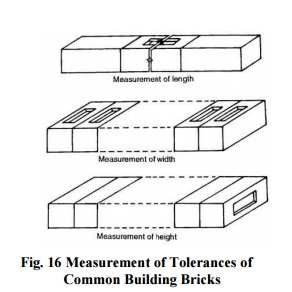
Testing Of Bricks
About fifty pieces of bricks are
taken at random from different parts of the stack to perform various tests. For
the purpose of sampling, a lot should contain maximum of 50,000 bricks. The
number of bricks selected for forming a sample are as per Table 2.3, (IS:
5454). The scale of sampling for physical characteristics is given in Table
2.4.
Table 2.
Scale of Sampling and Permissible Number of Defectives for Visual and
Dimensional Characteristics
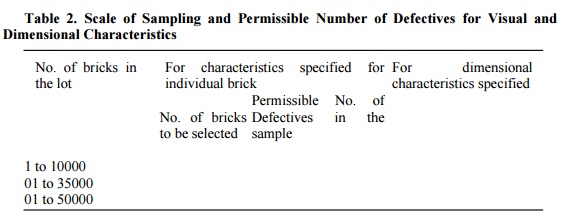
Note: In
case the lot contains 2000 or less bricks, the sampling shall be subject to
agreement between the purchaser and supplier.
Table 3.
Scale of Sampling for Physical Characteristics
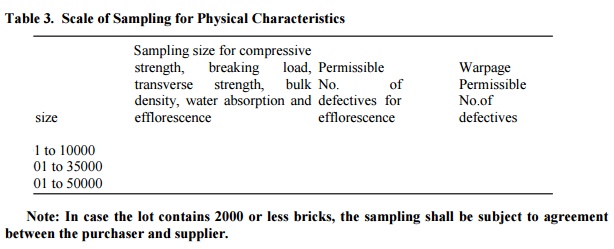
Note: In
case the lot contains 2000 or less bricks, the sampling shall be subject to
agreement between the purchaser and supplier.
Dimension
Test (IS: 1077): 20 pieces out of selected pieces (Table)
are taken and are laid flat as shown in Fig. 16.
The
tolerances (Section ) on the sizes of bricks are fixed by giving maximum and
minimum dimensions, not on individual bricks but on batches of 20 bricks chosen
at random.
It
follows from this method of measurement that batches are likely to contain,
bricks outside the prescribed limit of tolerance. Such lots should be rejected
to avoid complaints about the variation of perpends.
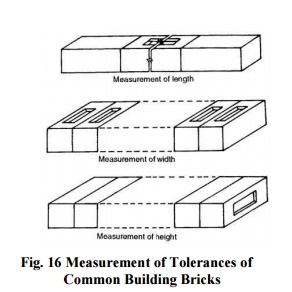
Water Absorption Test (IS: 3495 (Part II)): The
existence of minute pores confers marked capillary properties on brick
ceramics. In particular all bricks absorb water by capillary action. The percentage
of water absorption is a very valuable indication of the degree of burning.
Vitrification, in the true sense, corresponds to such a dgree of compactness
that the absorption of the brick is not over 3 per cent after 48 hours of
immersion. It has been reported that for absorption less than 5 per cent danger
from frost is negligible.
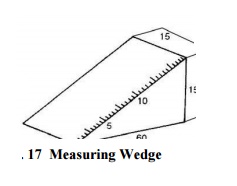
Water absorption does not necessarily indicate the
behavior of a brick in weathering. Low absorption (< 7 %) usually indicates
a high resistance to damage by freezing, although some type of bricks of much
higher absorption may also be frost resistance. Since expansive force of water
freezing in the pores of a clay product depends upon the proportion of pore
space occupied, the ratio of the absorption after 24 hours submersion to the
absorption after boiling for 5 hours (C24/B5) appears to
be a better criterion of resistance to freezing than the percentage of
absorption.
The
durability of a brick may be tested by frost action, i.e., by alternate wetting
and drying. The absorption test has long been considered a measure of
durability, although the basis for this assumption is questionable. The suction
rate of the brick at the time it is laid exercises a mark influence on the
mortar bond. Too rapid withdrawal of water from the mortar by the brick
produces a weak bond. The rate at which a brick absorbs water, frequently
called its suction rate, maybe measured by immersing one face of the brick in
water. The one minute water uptake (initial rate of absorprion) is taken as the
suction rate. For long periods of immersion in theis test, the total wieght of
water absorbed per unit area,
w = AÖt
where, A is the water absorption coefficient
and t is the time elapsed in the test.
The standard methods of finding the absorption
value of the bricks are discussed below. If absorption by volume is desired it
can be obtained by multiplying the weight percentage by the apparent specific
gravity.24 Hours Immersion Cold Water Test: Dry bricks are put in an oven at a
temperature of 105 o to 115 o C till these attain constant mass. The weight (W1)
of the bricks is recorded after cooling them to room temperature. The bricks
are then immersed in water at a temperature of 27 o
± 2 o C for
24 hours. The specimens are then taken out of water and wiped with a damp
cloth. Three minutes, thereafter it is weighed again and recorded as W2.
The water
absorption in % = w2-w1/ w1 x 100
The average water absorption shall not be more
than 20 per cent by weight upto class 12.5 and 15 per cent by weight for higher
classes.
Five
Hours Boiling Water Test: The weight of the oven dried bricks (W1)
is recorded as above. Then the specimen is immersed in the water and boiled for
five hours, followed by cooling down to 27 o ± 2 o C by natural loss of heat
within 16-19 hours. The specimen is taken out of water
and wiped with a damp cloth and the weight is recorded as W3.
The water
absorption in % = W3W1 / W1 - 100
Compressive
Strength Test (IS: 3495 (Part I)): The crushing affords a basis for
comparing the quality of bricks but is of little value in determining
the strength of a masonry wall, since the latter depends primarily on the
strength of mortar. Six bricks are taken for the compressive strength test
althought it may be found that an individual brick varies by 20% or more from
the average, the permissible stresses allowed for load bearing walls take
account of this, being based on an average strength of six bricks. It is,
therefore, both unnecessary and uneconomical to insist that every bricks is
above a certain strength. As a criterion of structural strength for brick, the
transverse failure in a wall or pavement is likely to occur on account of
improper bedment. For testing bricks for compressive strength from a sample the
two bed faces of bricks are ground to provide smooth, even and parallel faces.
The bricks are then immersed in water at room temperature for 24 hours. These
are then taken out of water and surplus water on the surfaces is wiped off with
cotton or a moist cloth. The frog of the brick is flushed level with cement
mortar and the brick is stored under damp jute bags for 24 hours followed by
its immersion in water at room temperature for three days. The specimen is
placed in the compression testing machine with flat faces horizontal and mortar
filled face being upwards. Load is applied at a uniform rate of 14 N/m2
per minute till failure. The maximum load at failure divided by the average
area of bed face gives the compressive strength.
Compressive
strength (N/mm2)
= M aximum load at failure (N) / A verage area
of bed faces (mm)
average
of results shall be reported. The compressive strength of any individual brick
tested in the sample should not fall below the minimum average compressive
strength specified for the corresponding class
of brick by
more than percent.
Warpage Test (IS:3495 (Part IV):
Warpage of the brick is measured with the help of a flat steel or glass surface
and measuring ruler graduated in 0.5 mm divisions or wedge of steel 60 × 15 ×
15 mm (Fig. 17 ). For warpage test, the sample consists of 10 bricks from a
lot.
Concave Warpage: The flat surface of the brick is placed along
the surface to be measured selecting the location that gives the greatest
deviation from straightness. The greatest distance of brick surface from the
edge of straightness is measured by a steel ruler or wedge.
Convex Warpage: The brick is
place on the plane surface with the convex surface in contact with the flat
surface and the distances of four corners of brick are measured from the flat
surface. The largest distance is reported as warpage.
The higher of the distance measured in concave and
convex warpage tests is reported as warpage. Efflorescence Test (IS: 3495
(Part III)): The ends of the brick are kept in a 150 mm diameter porcelain
or glass dish containing 25 mm depth of water at room temperature (20 o -30 o C)
till the entire water is absorbed or evaporated. The water is again filled to
25 mm depth in the dish and allowed to be absorbed by the brick or evaporated.
Presence of efflorescence is classified as below.
When the
deposit of efflorescence is imperceptible.
ht When the deposit of efflorescence
does not cover more than 10 per cent
he
exposed area of the brick.
derate When the deposit of efflorescence
is more than 10 per cent but less than
of the
exposed area of the brick.
When the
deposit of efflorescence is more than 50
per cent but the
vy osits
not powder
or flake away the brick surface.
ous When the deposits are heavy and
powder or flake away the brick surface.
The
specifications limit the efflorescence to be not more than moderate (10-50%) up
to class and not more than slight (< 10 per cent) for higher classes.
Related Topics